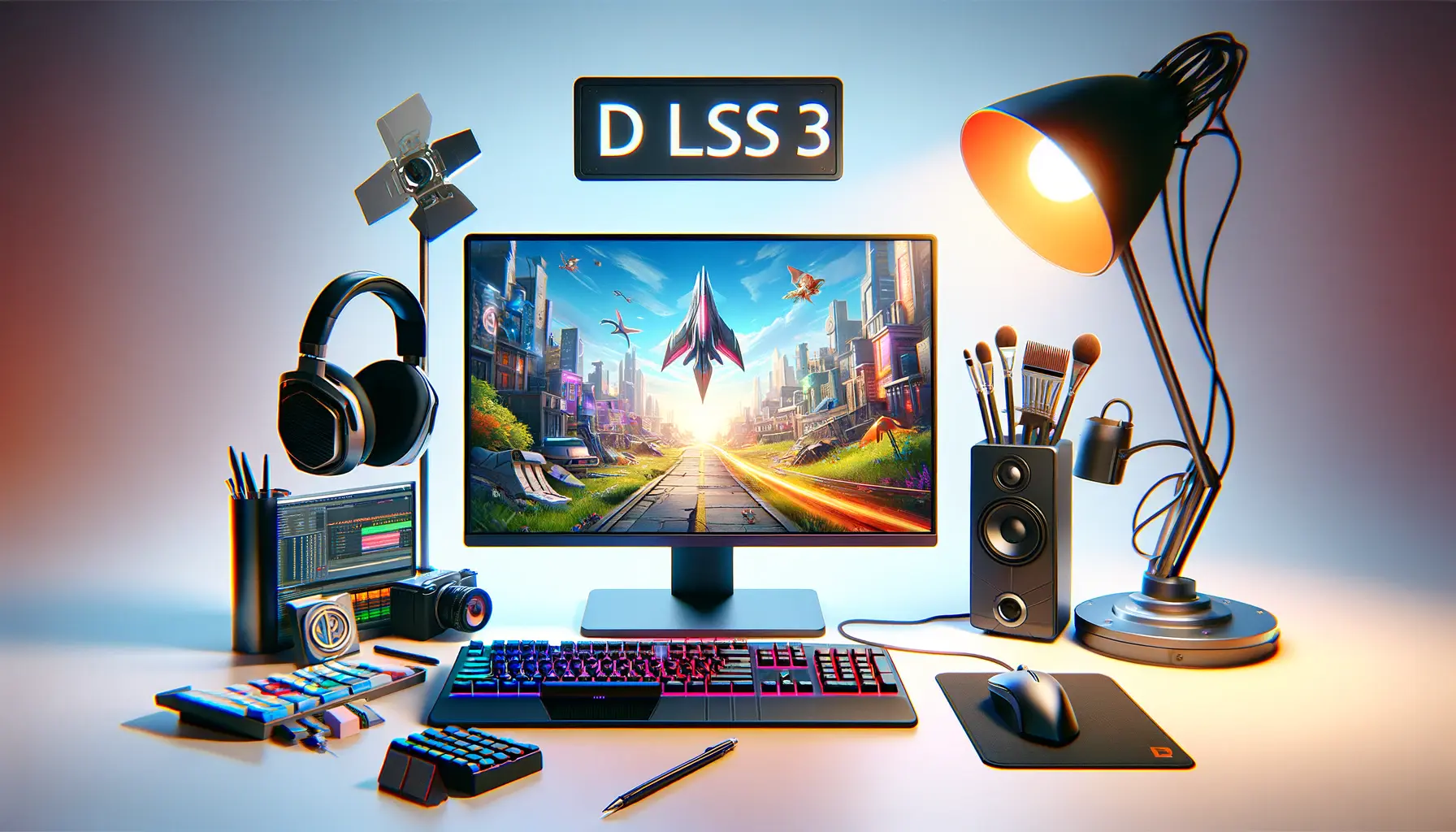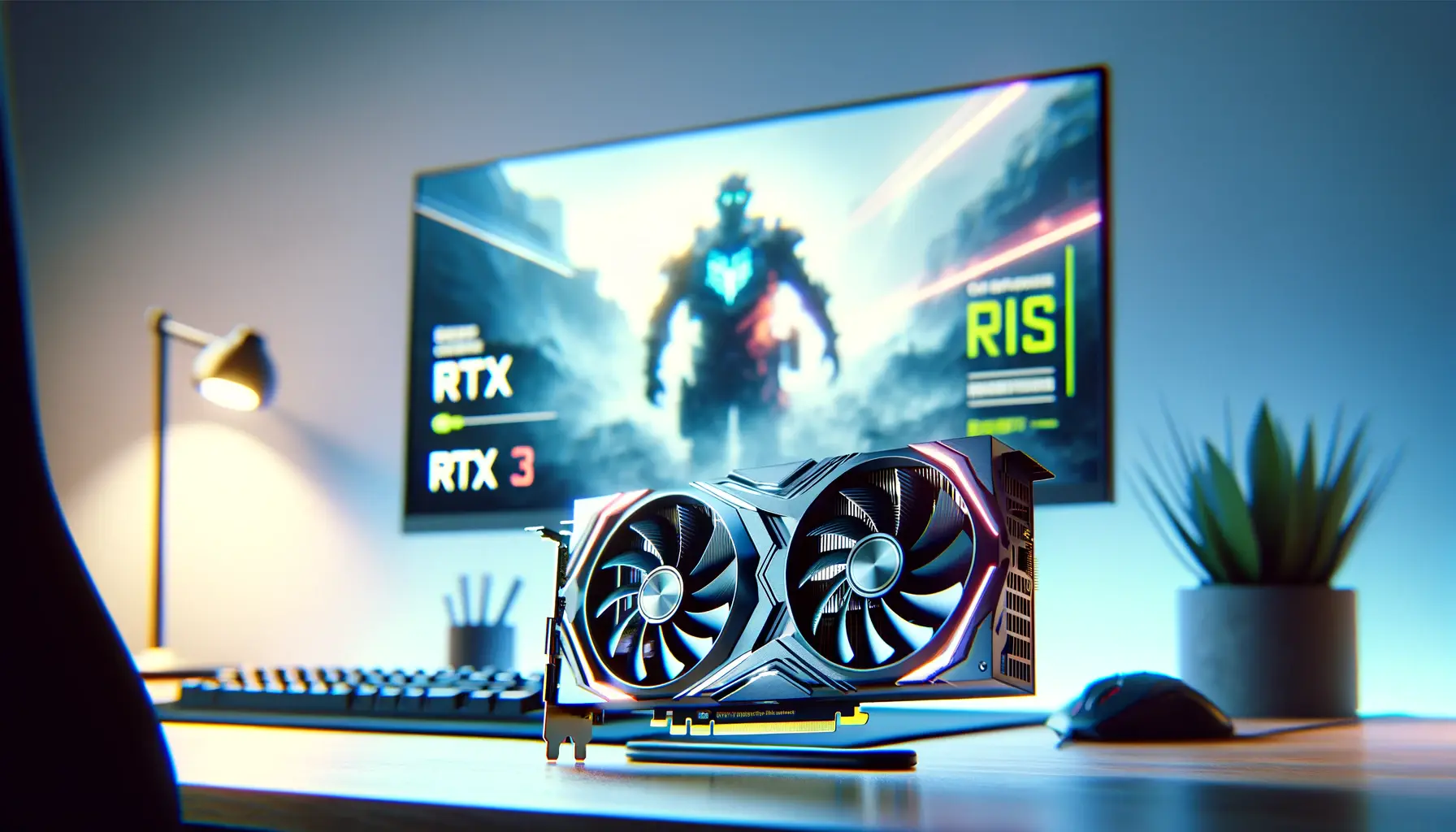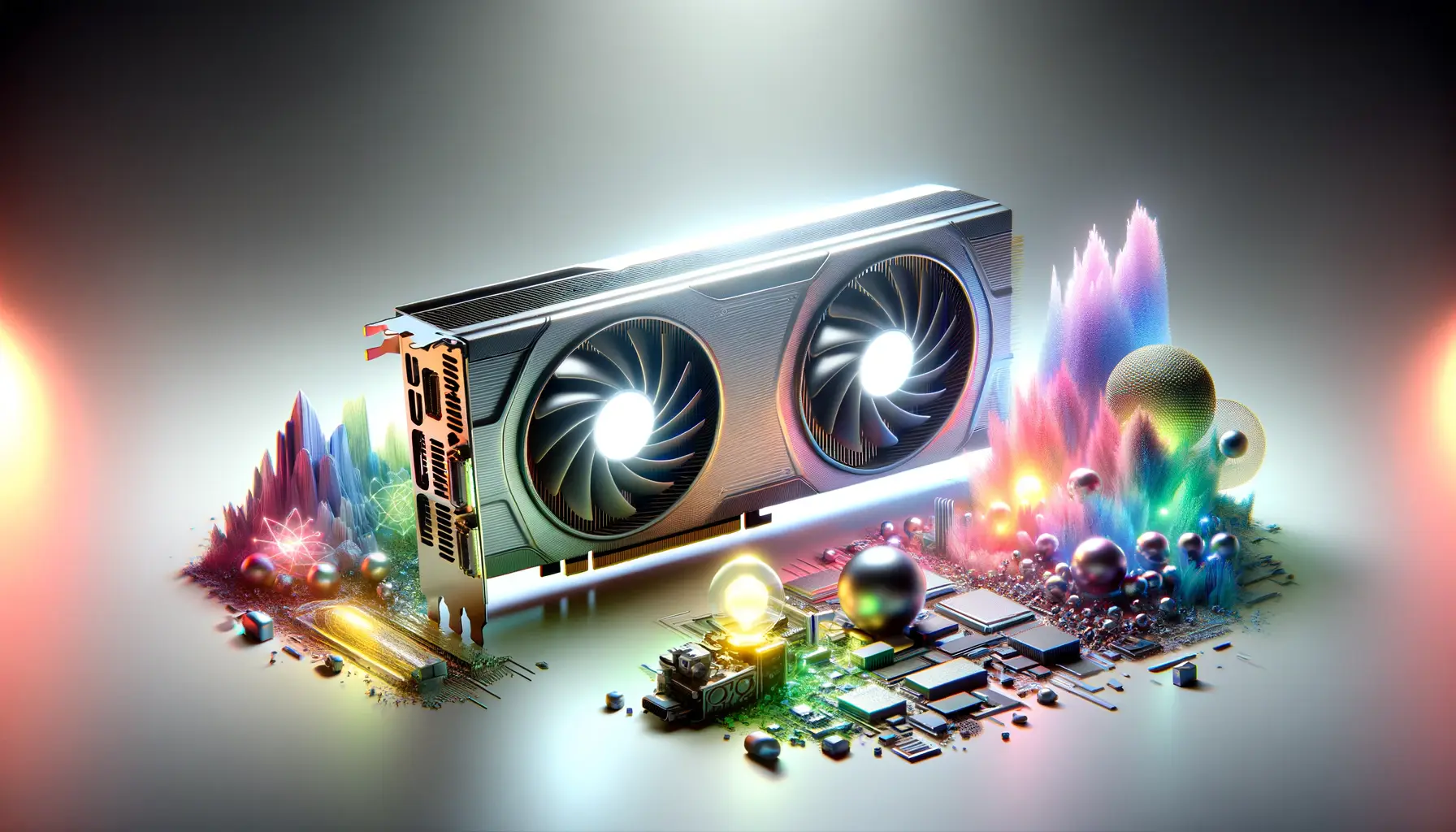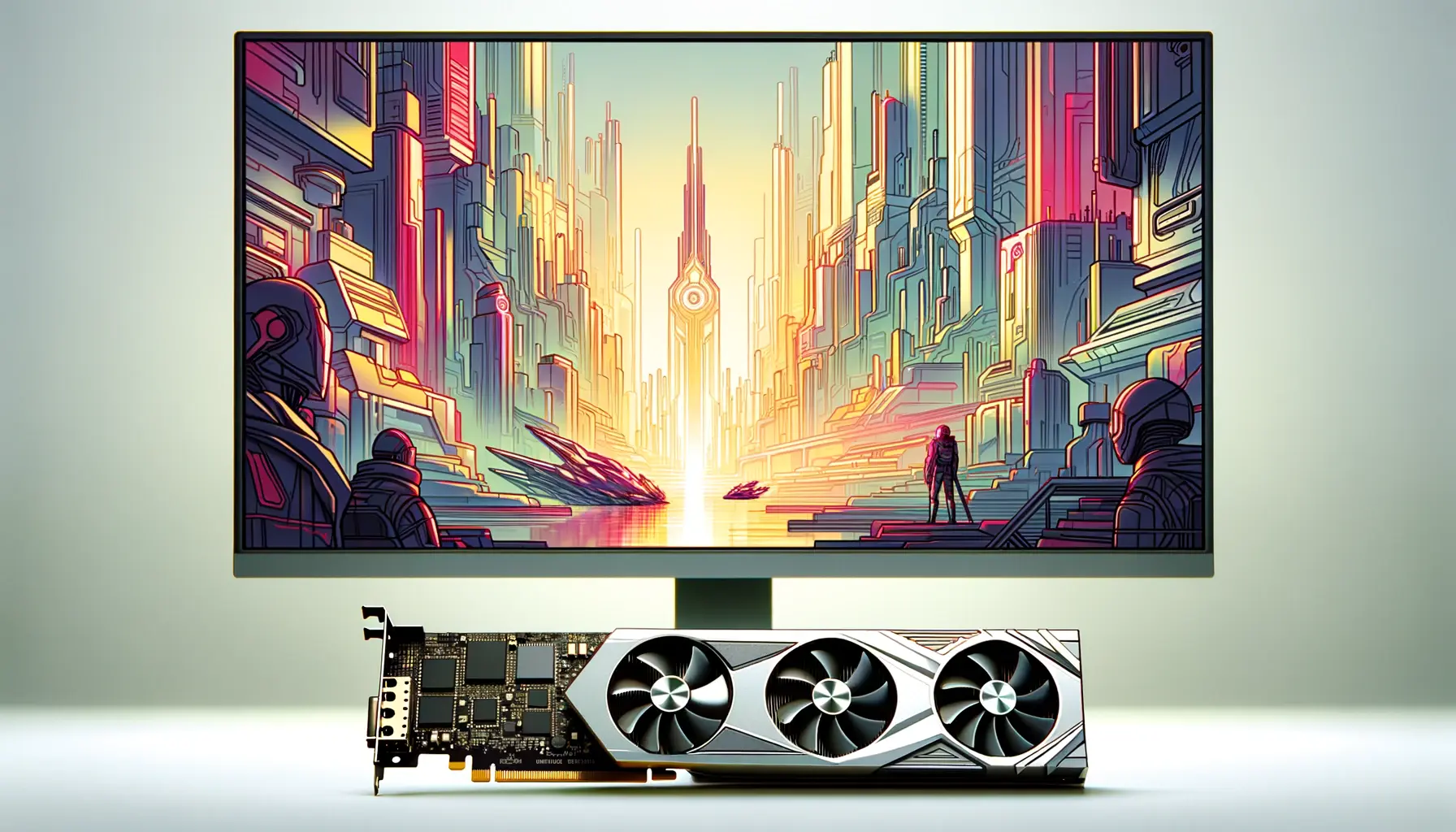The gaming industry is currently witnessing a significant technological leap, thanks to NVIDIA’s introduction of Deep Learning Super Sampling (DLSS) 3.
This advanced AI-driven rendering technology has set a new benchmark for game development, offering unprecedented performance enhancements and visual fidelity.
The adoption of DLSS 3 by game studios marks a pivotal moment, reshaping the landscape of gaming graphics and performance optimization.
DLSS 3, with its innovative approach to frame generation and AI-powered super-resolution, enables games to run at higher frame rates without compromising on visual quality.
This is particularly crucial in an era where gamers demand both ultra-high-definition visuals and smooth gameplay experiences.
NVIDIA’s DLSS 3 technology leverages the power of AI to meet these demands, offering a solution that significantly boosts performance while maintaining, or even enhancing, the game’s graphical detail.
- The Evolution of DLSS and Its Impact on Gaming
- Key Benefits of DLSS 3 for Game Developers and Players
- Challenges and Considerations in Implementing DLSS 3
- DLSS 3 in Action: Real-World Game Enhancements
- Future Directions and Potential of DLSS 3
- Community and Developer Feedback on DLSS 3
- DLSS 3 and the Broader Impact on the Gaming Industry
- Embracing the Future with DLSS 3
- DLSS 3 Adoption by Game Studios: FAQs
The Evolution of DLSS and Its Impact on Gaming
Understanding DLSS Technology
At its core, DLSS (Deep Learning Super Sampling) is a groundbreaking AI-based rendering technology that increases graphics performance using dedicated Tensor Core AI processors on GeForce RTX GPUs.
DLSS achieves this by intelligently upscaling lower-resolution images in real-time, allowing games to be rendered at a lower resolution for higher performance, then upscaled to the target resolution, ensuring pristine image quality that rivals native rendering.
The evolution from DLSS 1.0 to DLSS 3.0 has been nothing short of revolutionary.
Each iteration brought significant improvements over the last, with DLSS 2.0 introducing more efficient and flexible upscaling algorithms, and DLSS 3.0 now incorporating AI-powered frame generation.
This not only multiplies frame rates but also reduces latency, providing a smoother and more immersive gaming experience.
The Adoption Rate and Game Studio Support
The adoption of DLSS 3 by game studios has been rapid and widespread, a testament to its effectiveness and the tangible benefits it offers.
Within months of its release, numerous high-profile games announced support for DLSS 3, showcasing the industry’s confidence in NVIDIA’s technology.
This swift integration into mainstream titles reflects the growing recognition of DLSS 3 as a game-changer for performance optimization and visual quality enhancement.
Game studios, both large and small, have embraced DLSS 3, integrating it into a variety of genres, from fast-paced shooters to expansive open-world adventures.
This wide-ranging adoption underscores the versatility of DLSS 3 and its ability to cater to diverse gaming experiences, ensuring that more players can enjoy the benefits of higher frame rates and superior image quality across a broad spectrum of games.
DLSS 3’s rapid adoption by game studios signifies a major shift towards AI-driven game development, promising a future where gamers no longer have to choose between performance and visual quality.
Key Benefits of DLSS 3 for Game Developers and Players
The introduction of DLSS 3 into the gaming ecosystem has not only revolutionized the way games are played but also how they are developed.
This technology offers a plethora of benefits that cater to both game developers and the gaming community at large.
By leveraging the power of AI, DLSS 3 ensures that the visual fidelity of games is not sacrificed for performance, thereby aligning with the expectations of modern gamers who seek immersive and fluid gaming experiences.
For game developers, DLSS 3 presents an opportunity to push the boundaries of game design and graphics.
It allows for the creation of more detailed and expansive game worlds without the fear of performance bottlenecks.
This is particularly beneficial for independent studios that may not have the resources for extensive optimization processes.
The ease of integration offered by NVIDIA also means that developers can implement DLSS 3 without a significant overhaul of their existing workflows.
Enhanced Gaming Experience
- Higher Frame Rates: By generating additional frames, DLSS 3 significantly boosts the frame rates, making games run smoother than ever before.
- Improved Image Quality: DLSS 3’s super-resolution techniques ensure that the upscaled images maintain high quality, often indistinguishable from native resolutions.
- Reduced Latency: The AI-powered frame generation also contributes to reduced latency, providing a more responsive gaming experience.
Streamlined Development Process
- Resource Efficiency: DLSS 3 allows developers to optimize their games for performance without dedicating extensive resources to manual optimization techniques.
- Broader Accessibility: With DLSS 3, games can run on a wider range of hardware, making them accessible to a broader audience.
- Future-proofing: Integrating DLSS 3 prepares games for future hardware advancements, ensuring longevity and relevance in the rapidly evolving gaming market.
The adoption of DLSS 3 is a strategic move for game studios looking to future-proof their titles and provide gamers with the best possible experience.
Challenges and Considerations in Implementing DLSS 3
While DLSS 3 offers numerous advantages, its implementation is not without challenges.
Game studios must navigate a series of considerations to fully leverage the technology’s potential.
These challenges range from technical integration to ensuring compatibility across various hardware configurations.
Understanding these hurdles is crucial for developers aiming to incorporate DLSS 3 into their titles effectively.
One of the primary considerations is the requirement for GeForce RTX series GPUs, as DLSS 3 utilizes the specific AI capabilities of these cards.
This necessitates a careful approach to game design and marketing, ensuring that potential players are aware of the hardware requirements.
Additionally, the dynamic nature of AI-driven technologies means that ongoing updates and optimizations may be necessary to maintain the desired performance and image quality levels.
Technical Integration and Optimization
- Compatibility: Ensuring that games with DLSS 3 support run smoothly across all supported RTX GPUs, taking into account the varying levels of processing power.
- Testing and Quality Assurance: Rigorous testing is required to fine-tune DLSS 3’s performance, necessitating a comprehensive QA process to identify and address any issues.
Market and Audience Considerations
- Hardware Requirements Communication: Clearly communicating the hardware requirements to the gaming community to manage expectations regarding performance and compatibility.
- Adoption Among Gamers: Encouraging gamers to adopt the necessary hardware to experience the full benefits of DLSS 3, which may involve educational efforts about the technology’s advantages.
Despite the challenges, the strategic implementation of DLSS 3 can significantly enhance game performance and visual quality, setting a new standard for the gaming experience.
DLSS 3 in Action: Real-World Game Enhancements
The real-world impact of DLSS 3 on games is both profound and transformative.
By examining specific titles that have integrated DLSS 3, we can observe tangible improvements in performance, visual fidelity, and overall gameplay experience.
These enhancements not only benefit the players but also serve as a testament to the technology’s potential in reshaping the future of gaming.
Games like “Cyberpunk 2077,” “Forza Horizon 5,” and “Redfall” have become benchmarks for DLSS 3’s capabilities.
In “Cyberpunk 2077,” for instance, DLSS 3 has enabled smoother frame rates while maintaining the game’s intricate details and expansive world.
This has significantly improved the gaming experience, especially in fast-paced action sequences where every frame counts.
Case Studies of DLSS 3 Implementation
- Cyberpunk 2077: Showcased a remarkable improvement in frame rates and image quality, making the neon-lit streets of Night City more immersive than ever.
- Forza Horizon 5: Benefited from increased frame rates and reduced latency, enhancing the sense of speed and responsiveness in this high-octane racing game.
- Redfall: Utilized DLSS 3 to maintain high performance without compromising on the game’s visual complexity, ensuring a seamless vampire-slaying experience.
These case studies highlight DLSS 3’s role in enabling game developers to push the limits of what’s possible, creating richer, more detailed, and fluid gaming worlds.
The technology’s impact extends beyond individual titles, setting a new benchmark for the industry and influencing future game development trends.
DLSS 3’s implementation in these titles demonstrates its effectiveness in enhancing game performance and visual quality, offering a glimpse into the future of immersive gaming experiences.
Future Directions and Potential of DLSS 3
The advent of DLSS 3 has opened up new horizons in game development and performance optimization.
As we look towards the future, the potential applications and improvements of this technology are vast and varied.
The continuous evolution of AI and machine learning algorithms promises even more sophisticated rendering techniques, potentially revolutionizing the way games are designed and experienced.
Moreover, the integration of DLSS 3 into more game engines and development tools could lower the barriers for its adoption among developers.
This would not only enhance the visual quality and performance of a wider range of games but also foster innovation in game design, enabling creators to explore new possibilities without being constrained by hardware limitations.
Expanding the Ecosystem
- Broader support across game engines and platforms, facilitating easier integration for developers.
- Collaboration with hardware manufacturers to optimize DLSS 3 for a wider range of GPUs, increasing accessibility for players.
Innovations in Gaming Experiences
- Development of new genres and gameplay mechanics that leverage the enhanced capabilities of DLSS 3.
- Improvements in virtual reality (VR) and augmented reality (AR) experiences through more efficient rendering techniques.
The potential of DLSS 3 extends beyond current gaming applications, hinting at a future where real-time cinematic-quality rendering becomes the norm.
As NVIDIA and other stakeholders continue to refine and expand the technology, the gaming community can look forward to a new era of immersive and visually stunning gaming experiences.
The future of DLSS 3 is not just about enhancing game visuals and performance but also about redefining the possibilities of game development and player experiences.
Community and Developer Feedback on DLSS 3
The gaming community and developers have been vocal about their experiences and feedback regarding DLSS 3, offering valuable insights into the technology’s impact and areas for improvement.
This feedback loop is crucial for NVIDIA and game studios as they continue to refine DLSS 3, ensuring it meets the evolving needs of gamers and developers alike.
From forums to social media, the consensus among gamers has been overwhelmingly positive, with many praising DLSS 3 for breathing new life into older titles and enabling a smoother experience in newer games.
Developers, on the other hand, have highlighted the ease of integration and the significant performance gains as key benefits, while also suggesting areas for further enhancement.
Positive Reception and Constructive Criticism
- Players have reported noticeable improvements in frame rates and visual quality, particularly in graphically intensive games.
- Developers appreciate the support and resources provided by NVIDIA, facilitating the adoption of DLSS 3 in their projects.
Areas for Improvement
- Some users have noted occasional artifacts in specific scenarios, pointing to the need for ongoing optimization.
- Developers seek more granular control over DLSS settings to fine-tune performance and quality according to their game’s specific requirements.
The feedback from both communities is a testament to DLSS 3’s transformative potential while also serving as a roadmap for its continuous improvement.
By addressing the constructive criticism and building on the positive aspects, NVIDIA and game studios can further enhance the DLSS 3 experience for all users.
Listening to community and developer feedback is essential for the evolution of DLSS 3, ensuring it remains at the forefront of gaming technology advancements.
DLSS 3 and the Broader Impact on the Gaming Industry
The introduction and rapid adoption of DLSS 3 have far-reaching implications for the gaming industry as a whole.
Beyond individual game enhancements, this technology is setting new standards for performance and visual quality, influencing game development practices, hardware requirements, and even player expectations.
The ripple effects of DLSS 3’s success can be observed in various aspects of the industry, from the way games are marketed to the competitive landscape among GPU manufacturers.
As more studios incorporate DLSS 3 into their titles, we’re likely to see a shift in how games are developed and presented to consumers.
This includes a greater emphasis on visual fidelity and performance as selling points, potentially reshaping marketing strategies and consumer priorities.
Furthermore, the technology’s impact extends to hardware sales, with gamers increasingly seeking out compatible GPUs to take full advantage of DLSS 3’s capabilities.
Influencing Game Development and Marketing
- DLSS 3 is becoming a key feature in game development, encouraging studios to prioritize performance optimization and visual enhancements.
- Marketing efforts are increasingly highlighting DLSS 3 support as a major selling point for new titles, influencing consumer purchasing decisions.
Shaping Hardware Trends and Consumer Behavior
- The demand for DLSS 3-compatible GPUs is driving hardware trends, with consumers showing a preference for NVIDIA’s RTX series.
- As DLSS 3 becomes more prevalent, gamers are adjusting their expectations, seeking out games that offer the best balance of performance and visual quality.
The broader impact of DLSS 3 on the gaming industry underscores its significance as a technological milestone.
By pushing the boundaries of what’s possible in game performance and visual fidelity, DLSS 3 is not only enhancing the gaming experience but also driving innovation and competition within the industry.
As we look to the future, the continued evolution of DLSS and similar technologies will undoubtedly play a pivotal role in shaping the landscape of gaming.
The influence of DLSS 3 extends beyond individual games, affecting game development, marketing strategies, hardware trends, and consumer expectations across the gaming industry.
Embracing the Future with DLSS 3
The journey of DLSS 3 from its inception to becoming a cornerstone of modern gaming technology illustrates a significant leap forward in the pursuit of harmonizing performance with visual fidelity.
As game studios continue to adopt DLSS 3, the gaming landscape is undergoing a transformation, marked by an era where gamers no longer have to compromise between silky-smooth frame rates and breathtaking visuals.
This technology not only enhances the gaming experience but also serves as a catalyst for innovation within the industry.
The Path Forward for Game Studios
The widespread adoption of DLSS 3 by game studios signifies a pivotal shift towards more immersive and visually stunning gaming experiences.
As developers harness the power of AI to push the boundaries of what’s possible, we can expect to see games that are not only more beautiful but also more expansive and complex.
The future of game development looks bright, with DLSS 3 paving the way for new possibilities in storytelling, game design, and player engagement.
Revolutionizing Player Experiences
For players, DLSS 3 has redefined expectations for performance and quality.
The ability to experience games at their highest visual settings without sacrificing frame rates has become a new standard, one that will continue to shape how games are played and enjoyed.
As more titles integrate DLSS 3, players will increasingly seek out this technology, making it a key factor in hardware purchasing decisions and game selection.
- Enhanced Visuals: Players can enjoy games with unprecedented detail and clarity, bringing virtual worlds to life like never before.
- Smooth Performance: The promise of higher frame rates without compromise ensures a seamless and responsive gaming experience.
- Future-Proof Gaming: With DLSS 3, players can invest in the future of gaming, confident that their hardware will continue to deliver exceptional experiences.
Conclusion: A New Era of Gaming
In conclusion, DLSS 3 represents a monumental advancement in gaming technology, offering game studios and players alike the tools to transcend previous limitations.
The adoption of DLSS 3 by game studios is not just a trend but a testament to the industry’s commitment to innovation and excellence.
As we look to the future, the impact of DLSS 3 on the gaming industry will undoubtedly continue to grow, shaping the development of new titles and enhancing the way we experience games.
With DLSS 3, we stand on the brink of a new era in gaming, one filled with limitless potential and unprecedented possibilities.
DLSS 3 Adoption by Game Studios: FAQs
Explore the most common inquiries about DLSS 3 and its impact on gaming.
DLSS 3 is NVIDIA’s latest AI-driven rendering technology, enhancing game performance and visual quality by generating additional frames and upscaling images.
DLSS 3 is supported on NVIDIA GeForce RTX 40 Series GPUs, leveraging their advanced AI capabilities for optimal performance.
DLSS 3 boosts frame rates by intelligently generating additional frames, enhancing gameplay smoothness without compromising image quality.
Older RTX cards can benefit from DLSS 3’s improvements, except for the frame generation feature, which is exclusive to RTX 40 Series GPUs.
Over 35 games and applications, including “Cyberpunk 2077” and “Forza Horizon 5,” currently support DLSS 3, with more titles being added regularly.
Yes, DLSS 3 benefits a wide range of games, from fast-paced shooters to expansive open-world titles, by improving frame rates and visual fidelity.
DLSS 3 offers significant advancements over previous versions, including AI-powered frame generation and improved super-resolution techniques.
Yes, game developers must integrate DLSS 3 into their titles to enable its features, with NVIDIA providing resources to facilitate this process.












